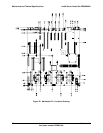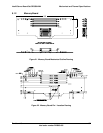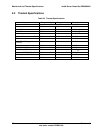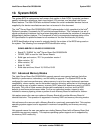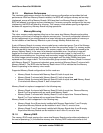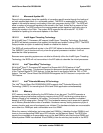
Intel® Server Board Set SE8500HW4 System BIOS
Revision 1.0
Intel order number D22893-001
71
10.1.3 Maximum Performance
The maximum performance mode is the default memory configuration and provides the best
performance. With four Memory Boards installed, the BIOS will configure memory as four-way
interleaved, across all the Memory Boards. With less than four Memory Boards installed, the
BIOS will attempt to configure two-way interleaving. If memory cannot be configured for two-way
interleaving, the BIOS will default to one-way. This memory mode allows sparing configuration
but does not support any Memory Board hot plug operations.
10.1.4 Memory Mirroring
The mirror memory mode requires either two or four same size Memory Boards and provides
redundancy at the cost of halving the effective memory size. The mirror configuration allows for
the hot replacement of an existing board for a board containing an equal amount of memory or
the hot addition of two Memory Boards to a pair of empty Memory Board slots only.
A pair of Memory Boards in memory mirror mode forms a redundant group. One of the Memory
Boards is designated the primary image and the other the secondary image. For memory writes,
the write request is issued to both boards. For memory reads, the read request is issued to the
primary Memory Board. In the event of a detected correctable error, the primary image will
toggle and the read will be issued to what was the old secondary image. In the event of a
detected uncorrectable error, the primary and secondary images will switch with each other and
the failed image cannot become the primary image again until the failed DIMMs have been
replaced and the image re-built. The first redundant group consists of Memory Board A mirrored
with Memory Board B. The second redundant group consists of Memory Board C mirrored with
Memory Board D. The BIOS sets the Memory Board mirror LED to indicate that the Memory
Board is operating in the memory mirror mode.
Supported Memory Board configurations for this mode are:
Memory Board A mirrored with Memory Board B, both of equal size
Memory Board C mirrored with Memory Board D, both of equal size
Memory Board A mirrored with Memory Board B, both of equal size; and Memory Board
C mirrored with Memory Board D, both of equal size.
Memory Board hot replace is supported in the following way:
Memory Board A mirrored with Memory Board B, both of equal size. Remove Memory
Board A or B and replace with an equal sized Memory Board
Memory Board C mirrored with Memory Board D, both of equal size. Remove Memory
Board C or D and replace with an equal sized Memory Board
Memory Board hot add is supported in the following way:
Memory Board A and B previously installed with Memory Board slots C and D empty.
Equal sized Memory Boards can be installed in slot C then D, one at a time.
Memory Board C and D previously installed with Memory Board slots A and B empty.
Equal sized Memory Boards can be installed in slot A then B, one at a time.
10.1.5 Memory RAID
The memory RAID mode requires four same size Memory Boards and provides redundancy at
the cost of quartering (¼) the effective memory size. Memory RAID mode acts similar to the






